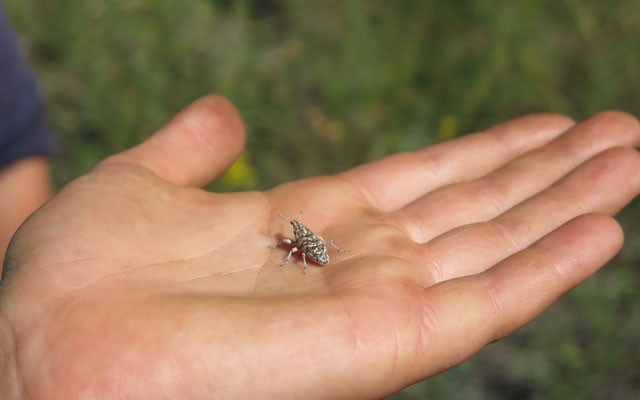Bugs have been let loose in the Sea to Sky, and they are not here to bite you or me. In fact, they are here to help us manage our invasive plants.
Invasive plants are plants that are not from here and have a negative impact. They have arrived from other parts of the world, most commonly via the horticulture trade. These plants are able to reproduce rapidly and quickly escape people's yards and gardens to spread into nearby natural areas.
Once a garden escapee, it is easy for seeds and burrs to stick to people, dogs, bikes and garden equipment, spreading further and further afield. A plant is considered invasive when it causes significant economic or environmental losses, or is a human health hazard. Knapweed is one of these plants in the Sea to Sky.
Knapweed is historically a farmer's weed. It grows extensively throughout the Southern Interior of B.C., taking over rangeland. In the Sea to Sky, it is a problem in Pemberton, where it grows well in the hot, dry summer climate and agricultural fields.
Knapweed actually wreaks chemical warfare on other plants around it, releasing chemicals into the soil that prevent other plants from growing. This reduces biological diversity in natural areas, and prevents the growth of farmer's much-needed crops. To top it off, Knapweed is full of natural oils, making expanses of this plant a fire hazard.
So how do we deal with it? Luckily, tiny root-and-flower-feeding beetles and moths help us out, a lot. Over a decade ago, the Ministry of Forests, Lands, and Natural Resource Operations released a few different species of beetles and weevils (Larinus spp and Cyphocleonus achates) and a moth (Agapeta zoegana) into infestations of Knapweed. These insects have been acting as "Biocontrol" agents ever since, silently munching away at the roots and seeds of invasive Knapweed each season, suppressing the plants growth and spread. Biocontrol is a long-term solution for invasive plant management — the biocontrol bugs are dependent on the knapweed plants to survive and thrive, so biocontrol will never eradicate knapweed in B.C.
However, it will keep the knapweed populations under control, reducing the need for alternate control measures such as herbicides and manual digging or pulling.
Biocontrol agents such as the beetles and moths that eat Knapweed are extensively studied and tested before being released in B.C. They are researched by scientists around the world who check to see if the insects will opportunistically or preferentially eat other native plants of economic or environmental importance when given the choice. Biocontrol agents must only eat and develop on the target invasive plant before being approved for release.
It is easy to forget that these bugs are hard at work, but our Sea to Sky corridor would be very different without them. Infestations of Knapweed would likely line the roadsides, farmers in Pemberton would face challenging crop losses, and fires would spread quickly and easily through fields.
Recently, Knapweed has been spreading southward from Pemberton. Patches of the plant have been popping up along the highway throughout the Whistler and Squamish areas. This may be due to a shifting climate, making these areas more hospitable to Knapweed. It may also be due to people and traffic spreading the seeds southwards along Highway 99.
Regardless of the reason, the Sea to Sky Invasive Species Council's field crews are actively monitoring these new sites, as well as older ones, for the presence of Biocontrol insects. Wherever the insects are present, we can count on them to suppress the knapweed population. Where they are not, further biocontrol releases or alternative measures need to be considered.
If you see Knapweed or any other invasive plant, you can help by reporting it using the Report-Invasives-BC app: www.reportaweedbc.ca
Breanne Johnson coordinates the Sea to Sky Invasive Species Council's Education and Outreach Program. For more information please visit www.ssisc.info.




